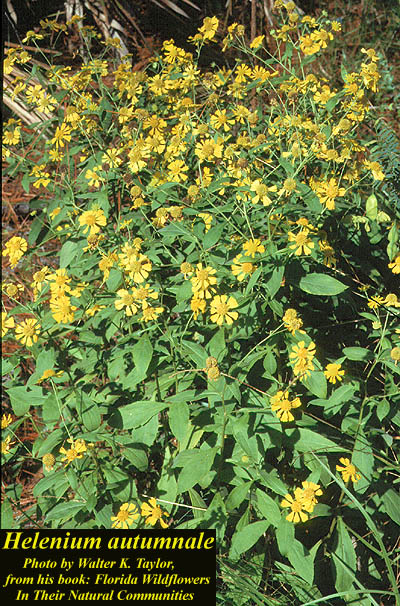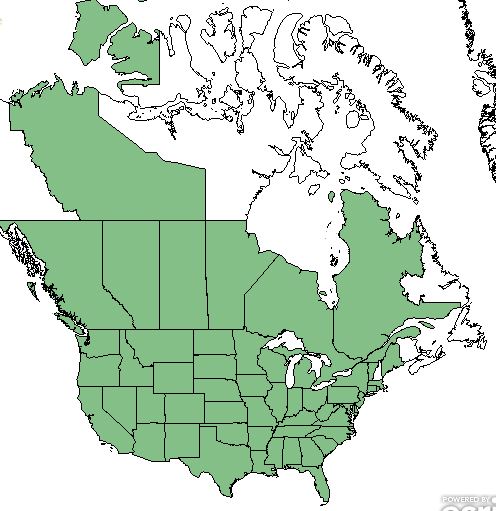Difference between revisions of "Helenium autumnale"
(→Ecology) |
|||
| Line 39: | Line 39: | ||
<!--===Seed bank and germination===--> | <!--===Seed bank and germination===--> | ||
<!--===Fire ecology===--> <!--Fire tolerance, fire dependence, adaptive fire responses--> | <!--===Fire ecology===--> <!--Fire tolerance, fire dependence, adaptive fire responses--> | ||
| − | + | ||
| + | ===Pollination=== | ||
| + | This species is thought by pollination ecologist to be of special value to native bees since it attracts such large numbers for pollination.<ref name= "lady bird"/> | ||
===Use by animals=== <!--Herbivory, granivory, insect hosting, etc.--> | ===Use by animals=== <!--Herbivory, granivory, insect hosting, etc.--> | ||
Revision as of 12:49, 21 May 2019
Common name: common sneezeweed
| Helenium autumnale | |
|---|---|

| |
| Photo by the Atlas of Florida Plants Database | |
| Scientific classification | |
| Kingdom: | Plantae |
| Division: | Magnoliophyta - Flowering plants |
| Class: | Magnoliopsida - Dicots |
| Order: | Asterales |
| Family: | Asteraceae |
| Genus: | Helenium |
| Species: | H. autumnale |
| Binomial name | |
| Helenium autumnale L. | |

| |
| Natural range of Helenium autumnale from USDA NRCS Plants Database. | |
Contents
Taxonomic Notes
Synonyms: Helenium latifolium P. Miller, and Helenium parviflorum Nuttall; H. autumnale L. var. parviflorum (Nuttall) Fernald; H. autumnale L. var. autumnale
The genus name Helenium is thought to be named by Linnaeus after Helen of Troy, since the legend is that flowers of this genus sprung up where her tears fell.[1]
Description
Also known as the common sneezeweed, H. autumnale is a native perennial forb that is a member of the Asteraceae family. It grows yellow conspicuous flowers and brown inconspicuous fruit.[2] It has a winged stem with daisy-like flower heads and drooping fan-shaped ray flowers; disk flowers form a greenish-yellow and conspicuous ball-like structure located in the center of the head. Flowers have overall raised centers with yellow wedge-shaped petals that have three teeth each. In size classes 1 to 3 feet or 3 to 6 feet tall.[1]
Distribution
H. autumnale can be found across the North American continent, from across the United States to most of Canada [2].
Ecology
Habitat
This species grows in a variety of communities, ranging from moist pastures to forests and woodlands. [3] More specifically, habitats range from shady and loamy sand in mesic hardwoods floodplains, sandy alluvial dikes, drainage ditches, pine flatwood depressions, wet woodlands, wet roadsides, moist soil of limestone bluffs, and other moist sandy loams.[4] It requires damp sites with moist clay soils usually, found in full sun in open areas along ponds and streams as well as wet meadows.[1] It is listed by the USDA Natural Resources Conservation Service as a facultative wetland species that most often occurs in wetland habitats but also can occasionally be found in non-wetland habitats.[2]
Phenology
Generally, H. autumnale flowers from September until October.[3] It has been observed to flower in September [5], but has been seen to be flowering in the months of June through November. It has been seen to develop fruit in the months June through November as well. [4]
Pollination
This species is thought by pollination ecologist to be of special value to native bees since it attracts such large numbers for pollination.[1]
Use by animals
It is considered bitter and unpalatable to grazing animals which in turn makes it more abundant in pastures.[3] The species consists of approximately 2-5% of the diet for various large mammals.[6] This species attracts various butterflies. For humans, the flowers, leaves, and seeds are poisonous but only toxic if ingested in large quantities. Symptoms of this condition include elevated pulse and temperature, salivation, vomiting, difficulty breathing, and convulsions. The toxic principle of this plant is sesquiterpene lactone. It derives its common name from the former use of the dried leaves for making snuff, which was inhaled to cause sneezing which would apparently rid the body of evil spirits.[1]
Conservation and Management
This species is considered to be weedy or invasive in Nebraska and the Great Plains region.[2]
Cultivation and restoration
Photo Gallery
References and notes
- ↑ 1.0 1.1 1.2 1.3 1.4 [[1]] Lady Bird Johnson Wildflower Center. Accessed: May 21, 2019
- ↑ 2.0 2.1 2.2 2.3 USDA Plants Database URL: https://plants.usda.gov/core/profile?symbol=HEAU
- ↑ 3.0 3.1 3.2 Weakley A. S.(2015). Flora of the Southern and Mid-Atlantic States. Chapel Hill, NC: University of North Carolina Herbarium.
- ↑ 4.0 4.1 Florida State University Robert K. Godfrey Herbarium database. URL: http://herbarium.bio.fsu.edu. Last accessed: June 2018. Collectors: Loran C. Anderson, Robert L. Lazor, Robert K. Godfrey, D. B. Ward, R. Kral, L. Redfeam, and J. Lazor. States and counties: Florida: Liberty, Jackson, Taylor, Wakulla, Montgomery, Franklin, Gadsden, Calhoun, Holmes, and Gulf. Georgia: Thomas.
- ↑ Nelson, G. PanFlora: Plant data for the eastern United States with emphasis on the Southeastern Coastal Plains, Florida, and the Florida Panhandle. www.gilnelson.com/PanFlora/ Accessed: 22 MAY 2018
- ↑ Miller, J.H., and K.V. Miller. 1999. Forest plants of the southeast and their wildlife uses. Southern Weed Science Society.